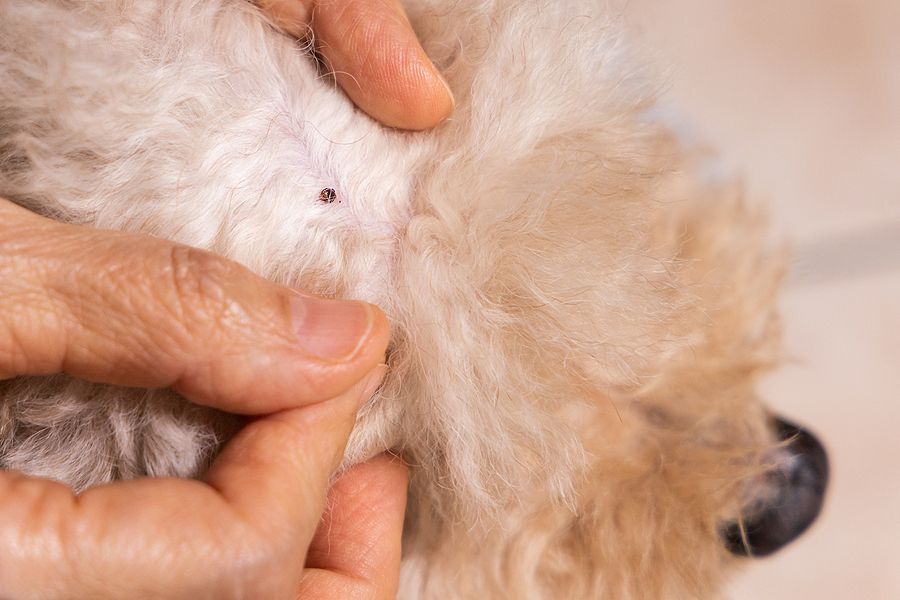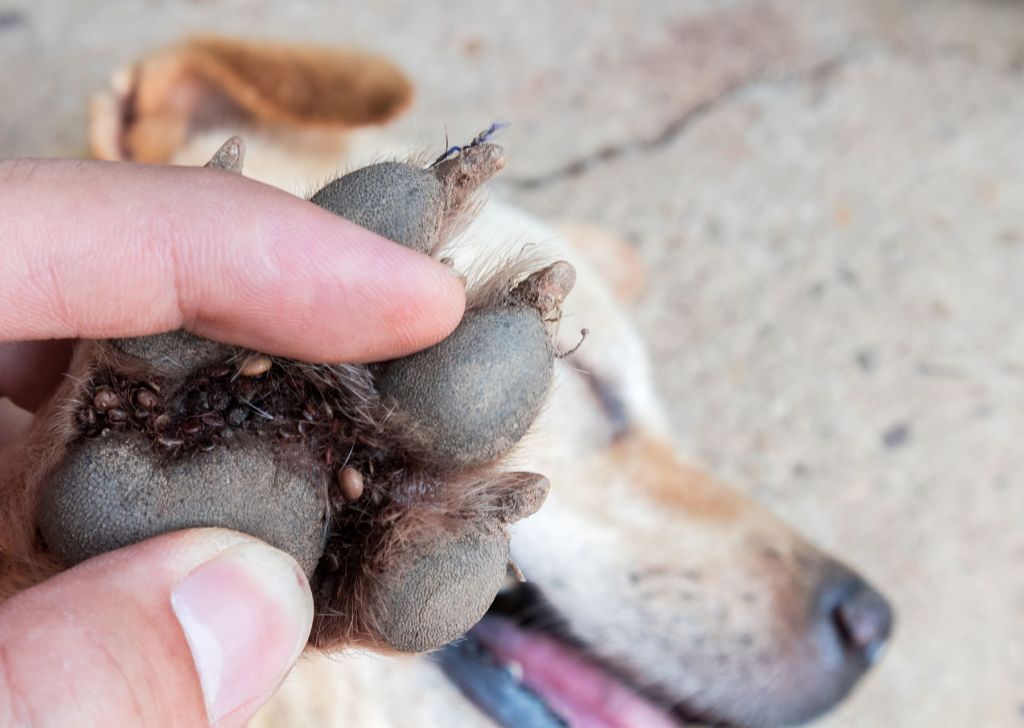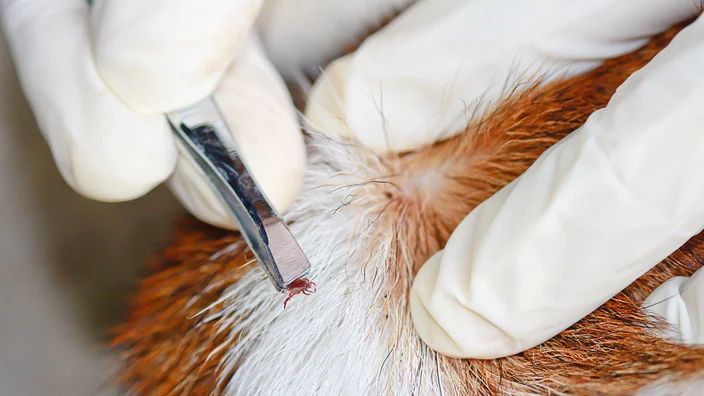Introduction
Ticks are small parasitic insects that feed on the blood of mammals, birds, and reptiles. When ticks attach and feed on dogs, they can transmit dangerous diseases like Lyme disease, anaplasmosis, ehrlichiosis, and babesiosis. Ticks can also cause skin irritation, infections, paralysis, and anemia in dogs. The goal of tick medicine for dogs is to kill and repel ticks in order to prevent disease transmission and other health issues. Tick prevention is crucial because ticks are widespread, active year-round even in cold weather, and their bites frequently go undetected.
Types of Tick Medicines
There are several effective prescription and over-the-counter tick medicines for dogs. Some of the most common options include:
Simparica Trio – This prescription medication protects against fleas, ticks, heartworms, and intestinal parasites. It is taken orally once a month.
Nexgard – An oral preventative that kills adult fleas and ticks. It is given once a month and is available by prescription.
Frontline Plus – Applied topically, this over-the-counter preventative kills fleas and ticks for one month. It is safe for dogs and puppies over 8 weeks old.

Seresto Collars – These collars release flea and tick repellent for 8 months. They are available over-the-counter.
Bravecto – Given orally every 12 weeks, this prescription medication kills fleas and multiple tick species, including deer ticks.
Revolution Plus – This topical medication protects against fleas, ticks, heartworms, roundworms, and hookworms. It requires a prescription and is applied monthly.
By discussing both prescription and over-the-counter options, as well as oral and topical preventatives, this covers the primary tick medicine choices for dogs.
How Tick Medicines Work
Tick medicines contain active ingredients that either kill ticks or repel them to prevent bites and disease transmission. Some common active ingredients in tick medications for dogs include:
– Pyrethroids like permethrin work as insecticides and repellents. They overexcite the nervous system of ticks, leading to paralysis and death (Source).
– Afoxolaner, fluralaner and sarolaner work by overstimulating insects’ nervous system, causing excess activity in nerves and muscles until death. They provide fast killing of ticks (Source).
– Isoxazolines like afoxolaner and fluralaner target receptors that mediate neurotransmitter gamma-aminobutyric acid (GABA), overexciting the tick’s nervous system (Source).
Overall, these ingredients overstimulate the nervous system of ticks, causing paralysis, hyperexcitation and death. This provides effective protection against tick bites and diseases for dogs.
Effectiveness Against Different Tick Species
Tick medicines vary in their effectiveness against different tick species. According to research, the most common ticks that affect dogs in the US are the deer tick (Ixodes scapularis), American dog tick (Dermacentor variabilis), brown dog tick (Rhipicephalus sanguineus), and Lone Star tick (Amblyomma americanum) (Pfister, 2016).
The isoxazoline class of medicines like fluralaner (Bravecto) and afoxolaner (Nexgard) have been found highly effective (>95%) against deer ticks and American dog ticks for at least one month after administration (PetMD, 2022). However, one study showed lower effectiveness (65-85%) against brown dog ticks (Pfister, 2016).
Permethrin-based spot-ons like Frontline Plus have also demonstrated high efficacy against deer ticks but require more frequent reapplication every 2-4 weeks. According to one analysis, a single application eliminated 55-100% of ticks on treated dogs (Pfister, 2016). However, permethrins tend to be less effective against Lone Star ticks.
Overall, isoxazolines appear most effective against a broad range of common tick species, but ongoing research is still needed to fully determine comparative efficacy across all tick varieties and regions.
Correct Administration
To ensure tick medicine is effective at killing and repelling ticks, it is crucial to administer it correctly. This involves giving the proper dosage, applying it to the right location on your dog’s body, and following the duration guidelines. Here are some tips for correct administration:
Dosage: Always follow the dosage guidelines on the product’s label or provided by your veterinarian. Dosage is usually determined by the dog’s weight. Under-dosing can reduce effectiveness, while overdosing can cause toxicity. Measuring your dog’s weight accurately and using the right topical applicator or chewable tablets is key.
Location: Topical tick preventatives should be applied on the skin at the back of the neck, between the shoulder blades. This allows the medication to distribute through the oils in the skin. Do not apply on broken skin or let your dog lick the area right after application.

Duration: Most tick medicines protect for 1-3 months per dose. It’s important to reapply as directed and not extend duration between doses, which reduces protection. Use tick medicines year round if ticks are present in your area.
By correctly administering tick medicine with the proper dosage, location, and duration, you can ensure your dog is fully protected against ticks. Always consult your veterinarian if you have questions.
Duration of Protection
Most flea and tick medications provide protection against ticks for 1-3 months, depending on the product. Some of the most popular oral and topical medications include:
Nexgard: Provides protection against ticks for 1 month. The chewable tablet kills ticks within 24 hours of administration (1).
Bravecto: Provides protection against ticks for 2-3 months. The chewable tablet kills ticks within 12 hours and prevents re-infestation during that time (2).
Revolution Plus: Provides protection against ticks for 1 month. The topical solution kills ticks and prevents re-infestation during that time (3).
Seresto Collar: Provides protection against ticks for 8 months. The collar repels and kills ticks which come into contact with it during that time (4).
It’s important to follow reapplication guidelines and not extend the protection window beyond the labeled duration. Check with your veterinarian to determine the best flea and tick prevention plan for your dog.
<1> https://www.petmd.com/dog/general-health/how-long-do-flea-and-tick-medications-take-work-dogs
<2> https://parasitesandvectors.biomedcentral.com/articles/10.1186/s13071-018-3043-x

<3> https://www.zoetispetcare.com/products/dogs/revolution-plus
<4> https://www.petbucket.com/Listing/search?keywords=seresto%20collar&searchType=2&sortItem=7&sortDirection=0
Safety and Side Effects
While tick medicines are generally safe when used as directed, some dogs may experience side effects like lethargy, vomiting, diarrhea, and loss of appetite (https://www.vet.cornell.edu/departments-centers-and-institutes/riney-canine-health-center/health-info/flea-and-tick-prevention). Certain active ingredients like permethrin can be toxic to cats, so it’s crucial to use only dog-safe products. There have also been rare reports of neurological side effects in some dogs treated with isoxazoline products like fluralaner and afoxolaner.
For dogs sensitive to tick medication ingredients, there are some alternatives. Botanical-based repellents containing ingredients like peppermint oil, lemongrass oil, and rosemary oil can provide short-term protection against ticks with minimal risk (https://www.nrdc.org/stories/nontoxic-ways-protect-your-pet). Just be aware these may need to be reapplied frequently. You can also look into natural tick collars containing essential oils. Tick checks and prompt removal are another chemical-free preventative measure. While not as convenient, these methods may be preferable for dogs that don’t tolerate typical tick medicines well.
Tick Checks and Removal
While tick medicine can be very effective at killing and repelling ticks, it is still important to regularly check your dog for any attached ticks. Ticks can sometimes attach in between application of the medication, so diligent tick checks are still essential.
According to the Humane Society, you should run your fingers slowly over your dog’s entire body to feel for any bumps or swollen areas where a tick may have attached [1]. Pay close attention to the ears, underarms, groin and between the toes. If you find an attached tick, grasp it as close to the skin as possible using tweezers and pull straight up slowly and steadily. Avoid crushing the tick’s body to prevent disease transmission. After removal, clean the area and monitor for any signs of infection.
Even when using tick medication, the AKC recommends checking your dog for ticks daily if possible, especially after time spent outdoors [2]. Catching and removing ticks promptly can help prevent transmission of disease. Tick medicine is not 100% effective so vigilance is still key.
Other Preventative Measures
In addition to topical and oral tick medicines, there are other ways to help prevent ticks on dogs:
- Vaccines: Certain vaccines are available that target specific tick-borne diseases like Lyme disease. While not 100% protective, they can help reduce the risk of disease transmission if a tick bite occurs. Talk to your veterinarian to see if tick-borne disease vaccines may be recommended in your area.
- Avoiding high-risk areas: Since ticks live in grassy, wooded, and bushy areas, limiting access to these habitats can reduce tick exposure. Stick to open, sunny trails when walking dogs.
- Tick habitat modification: Keep grass mowed and remove brush/leaf litter from yards. Creating a buffer of wood chips or gravel between lawns and wooded areas can help keep ticks away.
- Tick checks and prompt removal: Check dogs thoroughly for ticks after being outdoors, especially around the head, neck, and ears. Remove any found ticks promptly using tweezers.

Ask your veterinarian for guidance on the best tick prevention plan for your specific dog and lifestyle. A multi-pronged approach combining medicines, habitat modification, and vigilant tick checks is ideal.
Conclusion
In conclusion, there are several effective tick medicines available for dogs that can help prevent ticks from attaching and feeding. When used correctly, these medications can kill ticks and provide protection against common tick-borne diseases.
The most common tick medicines for dogs contain active ingredients like fipronil, permethrin, and pyriproxyfen. They work by either repelling ticks, quickly killing them upon contact, or disrupting their growth and reproduction. However, tick medicines are not 100% effective and proper administration is key.
It’s important to use the right product for your dog’s size and age. Consult your veterinarian if you have any concerns. Tick checks and prompt removal is still crucial, even when using preventatives. Combined with other measures like avoiding tall grasses, tick medicines reduce but do not completely eliminate the risk of ticks on dogs.
The key takeaways are that while tick medicine provides an important line of defense, diligence is still required by pet owners to prevent ticks and the diseases they can transmit to dogs.
